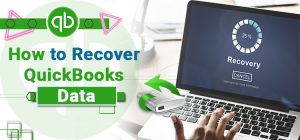
The QuickBooks Desktop includes a feature called Auto Data Recovery (ADR), which is extremely helpful in the event of data failure or corruption. This amazing tool’s unique selling point is that it will recover virtually 100 percent of your files. Yes, you can finally breathe a sigh of relief. Your Quickbooks data is completely safe and stable. Thank you so much for this fantastic tool.
This platform was first available in Quickbooks Pro and Premier. Auto data recovery was added to the Quickbooks Desktop Enterprise edition in 2012. In most cases, intuit data providers can restore data. However, the process will be cumbersome, and you will be unable to use QuickBooks for some days.
There are two methods for recovering data using Quickbooks Auto Data Recovery
- You will recover the missing transactions by using the new Transaction Log file and a backup of the Company file.
- Except for the last few hours of sales, everything has been recovered. This will be accomplished by making a backup of both the Company and Transaction Log files.
Remember this when attempting Auto Data Recovery
Quickbooks Auto Data Recovery is only available in the Pro, Premier, and Enterprise editions of Quickbooks.
- Data recovery is not included in the accountant editions.
- The maximum file size is 1.5 GB.
- You should be using the most up-to-date edition of Quickbooks.
Let us now look at how to restore QuickBooks Auto Data Recovery.
How does Auto Data Recovery QuickBooks work to restore data?
Carefully follow the instructions for each procedure one at a time.
Method 1: Using the Original.TLG File in Conjunction With the.QBW.adr Fil
To restore all recent transactions, use the original dealing Log file and the ADR version of the corporate file.
- Make a new folder on your Desktop called QBTest.
- Open the folder in which the business file is stored.
- Look for the .tlg file in the folder containing your business files. It’s got the same name as the business file.
Show file extensions
If you are unable to find the .tlg file, you must do this to display file extensions.
- To begin, press Windows+E on your keyboard to launch File Explorer.
- Now, click Organize, followed by Folder and search options.
- For Windows 10, 8.1, and 8, you must first pick View, then Filename extension.
- Then choose Hide extensions for recognized file types.
- Simply choose Apply, then Well.
- Locate the QuickBooksAutoDataRecovery folder and double-click it. It’s in the same folder as the business file.
- Copy and paste the.QBW.adr file into the QBTest folder. You must have a.QBW.adr and .tlg file in your QBTest folder right now.
- Right-click the.QBW.adr file in your QBTest folder and pick Rename.
- Delete the .adr extension at the top of the file.
- Launch QuickBooks.
- Open the corporate file located in your QBTest folder. Use the account register to square weigh all purchases.
- To check the information integrity of the recovered file, go to File, then Utilities, and finally Verify Data.
Read more – Methods to Resolve Quickbooks Error 15241
Method 2: Using the .QBW.adr and .TLG.adr Archives to Retrieve Recent Transactions
- Make a new folder on your desktop called QBTest.
- Explore the QuickBooksAutoDataRecovery folder in the folder where the corporate file is saved.
- Look for the files. TLG.adr and.QBW.adr. These files are named just the same as your business account.
- If you can’t find the. TLG.adr and.QBW.adr archives, use them to identify file extensions.
- Click Windows+E on your keyboard to launch File Explorer.
- Select Organize, then Folder and search options.
- For Windows 10, 8.1, and 8: Pick View, then Filename extension.
- Hide extensions for well-known file types.
- Choose Apply, then OK.
- Copy and paste the.TLG.adr and.QBW.adr files into the QBTest archive.
- Delete the .adr from the end of the file name in your QBTest folder. This should result in .qbw and .tlg files in your QBTest folder.
- Launch QuickBooks.
- Open the corporate file located in your QBTest folder. Check the account register to ensure that all purchases are recorded.
- To verify the information security of the restored file, go to the upper left and pick File, then Utilities, and finally Verify.
- If this copy of the corporate file is satisfactory, you can relocate the broken business file to a distinct location and pass the copy from QBTest to the original location.
But that’s how you can use Auto Data Recovery Quickbooks. We hope you get the most out of this message. If that’s the case, you can read some of the other posts on our website like Quickbooks Error 6000 77 . They would be very beneficial to you.